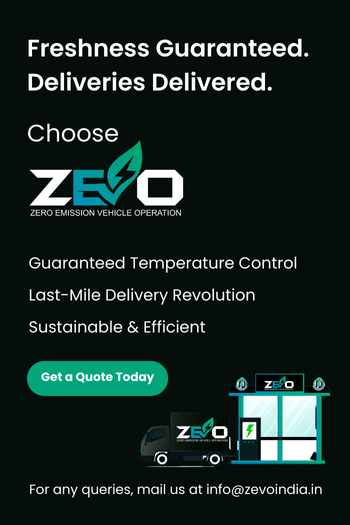The Environmental Impact of Refrigerated Last-Mile Delivery

Akshay Sharma
CEO's Office @ZEVO
The chill of convenience has a hidden cost. Refrigerated last-mile delivery, the process of getting fresh groceries, restaurant meals and even medications directly to our doorsteps, has become an essential part of modern life.
But the convenience we crave comes at a price: a growing environmental impact. Studies show that refrigerated deliveries alone contribute to a significant portion of the environmental burden associated with last-mile logistics.
Pollution from Refrigerated Deliveries
The convenience of having fresh food delivered comes with a hidden cost – pollution. Here’s a breakdown of the environmental impact:
- Diesels: Traditional delivery vehicles, often powered by diesel engines, are major contributors to air pollution. Diesel engines emit harmful pollutants like nitrogen oxides and particulate matter, known to cause respiratory problems and contribute to smog.
- Gasoline Powered Vehicles: These pollutants also include greenhouse gases (GHGs), primarily carbon dioxide (CO2). CO2 acts like a blanket in the atmosphere, trapping heat and contributing to climate change. The rapid rise in global temperatures disrupts weather patterns, melts glaciers, and threatens ecosystems.
- Electric Vehicles: A Step in the Right Direction: Electric vehicles (EVs) offer a significant advantage – they produce zero tailpipe emissions. This translates to cleaner air, especially in urban areas with high concentrations of delivery companies.
- The Battery Challenge: Electric vehicle production, particularly battery manufacturing, has an environmental footprint. Extracting raw materials and the energy used in battery production can generate pollution. However, this is an ongoing area of research and development, with manufacturers focusing on using more sustainable materials and cleaner energy sources.
Additionally, when we consider the entire lifespan of an EV, including its lower emissions during operation, the overall environmental impact is still significantly lower than gasoline-powered vehicles. Furthermore, as the electricity grid transitions to cleaner energy sources, the environmental benefits of EVs will only increase.
In essence, while EVs aren’t perfect, they offer a crucial step towards a more sustainable future for refrigerated deliveries.
Beyond Emissions: The Packaging Problem
Refrigerated deliveries rely heavily on specialized packaging to maintain food temperature during transport. But this comes at a cost – a mountain of waste. Let’s explore the environmental implications of these packaging materials:
- Plastic Wrap: A common and versatile option, plastic wrap helps insulate food and prevent leaks. However, traditional plastic wrap is often made from non-biodegradable materials, meaning it can take hundreds of years to decompose in landfills. Additionally, it’s easily torn and becomes litter, polluting our environment.
- Coolers with Ice Packs: These reusable coolers offer a more environmentally friendly option compared to disposable packaging. But they still require energy to manufacture and transport. The ice packs typically contain chemicals or gels that may need special disposal, and leaks can contaminate the environment.
- Dry Ice Containers: Dry ice (solid carbon dioxide) offers a powerful cooling solution, but it has its drawbacks. Dry ice sublimates (transitions directly from solid to gas) releasing CO2, a greenhouse gas, into the atmosphere. Additionally, dry ice containers are often made from non-biodegradable materials, adding to landfill waste.
Microplastic Menace: As plastic packaging breaks down over time, it can fragment into tiny pieces called microplastics. These microplastics pollute our oceans and waterways, entering the food chain and potentially harming wildlife and even human health.
The increasing demand for refrigerated deliveries creates a growing problem of packaging waste. In the next section, we’ll explore solutions for a more sustainable future.
Solutions for Sustainable Deliveries
The environmental impact of refrigerated deliveries is significant, but there’s hope! Here’s a look at some promising solutions:
Electric Vehicles (EVs): A Charged Future
Electric vehicles offer a significant advantage when it comes to reducing emissions from refrigerated deliveries. Let’s delve deeper:
- Benefits: EVs produce zero tailpipe emissions, meaning cleaner air in our cities and a reduced contribution to climate change. Additionally, electric motors are quieter than traditional combustion engines, reducing noise pollution in urban areas.
- Limitations: While EVs hold immense promise, they still have limitations to consider. Range anxiety, the fear of running out of power before reaching the destination, is a concern for some. However, battery technology is constantly improving, and newer models offer greater range capabilities. Another limitation is the availability of charging infrastructure. While charging stations are becoming more widespread, gaps still exist, especially in rural areas.
Compostable Packaging: A Greener Wrap
Compostable packaging offers a more sustainable alternative to traditional plastics. These materials are designed to break down naturally in industrial composting facilities, reducing landfill waste and microplastic pollution. Here’s a breakdown of some options:
- Plant-Based Materials: Packaging made from corn starch, sugarcane bagasse, or other plant-based materials can be composted into nutrient-rich soil. However, the suitability for different products varies. For example, plant-based containers might not be ideal for very wet or greasy foods.
- Biodegradable Plastics: These innovative plastics are designed to decompose under specific conditions (like high heat and moisture) in industrial composting facilities. They offer greater versatility compared to plant-based options, but composting infrastructure remains a key factor in their overall sustainability.
Beyond the Battery: Exploring Cutting-Edge Refrigeration
While electric vehicles and sustainable packaging are key elements, innovation extends to the refrigeration technology itself. Here’s a glimpse into some emerging solutions:
- Eco-Friendly Refrigerants: Traditionally, refrigerants relied on harmful chemicals like hydrofluorocarbons (HFCs) with high global warming potential. Today, the industry is adopting more environmentally friendly refrigerants with lower impact. Ammonia, for example, is a natural refrigerant gaining traction, although it requires careful handling due to its toxicity.
- Cryogenic Cooling: A Frigid Future?: For specialized applications requiring ultra-low temperatures, cryogenic refrigeration emerges as a potential solution. This technology utilizes liquefied gases like nitrogen (LN2) to achieve extremely cold temperatures.
While highly efficient, LN2 production requires significant energy input, and its evaporation releases nitrogen gas, a greenhouse gas. Cryogenic refrigeration may be suitable for niche applications where other options are impractical, but a life cycle assessment should be conducted to weigh its overall environmental impact. - Electroabsorption Cooling: A Silent Chill: This promising technology utilizes electricity and a special absorbent material to create a cooling effect. It offers a silent and potentially environmentally friendly option, especially when powered by renewable sources like solar or wind energy. However, electroabsorption cooling is still under development and its commercial viability for large-scale applications needs further exploration.
The Future of Urban Logistics: A Brighter Chill
The future of refrigerated deliveries in urban areas offers exciting possibilities for minimizing environmental impact:
- Delivery Drones: While still under development, drone delivery holds promise for reducing traffic congestion associated with traditional delivery vehicles. Drones can potentially deliver smaller packages over shorter distances with lower emissions. However, safety regulations and noise concerns need to be addressed before widespread adoption.
- Micro-Fulfillment Centers: Establishing smaller fulfillment centers within urban areas can shorten delivery distances. This reduces the environmental footprint associated with long-distance refrigerated transportation.
- Cargo Bike Deliveries: For shorter distances within urban areas, cargo bikes offer a sustainable alternative. These electric-powered or human-powered vehicles produce zero emissions and can navigate congested streets more efficiently.
Incentivizing Sustainable Choices
Consumers play a vital role in driving sustainable practices in the delivery industry. Delivery services can encourage eco-conscious choices by offering incentives:
- Reward Programs for Sustainable Choices: Programs that reward consumers for combining orders, opting for slower delivery options, or choosing carbon-neutral delivery methods can motivate more sustainable behavior. These rewards could take the form of discounts, points redeemable for future deliveries, or other benefits.
- Transparency and Education: Delivery services can increase transparency by clearly communicating the environmental impact of different delivery options. Educating consumers on the benefits of consolidating orders or opting for slower deliveries empowers them to make informed choices.
The future of refrigerated deliveries holds promise with advancements in refrigeration technology. As these solutions mature and become more cost-effective, they offer exciting possibilities for minimizing the environmental footprint of keeping our food fresh during transport.

Share this Article
Subscribe to our newsletter
Be the first to receive exclusive offers and the latest news on our products and services directly in your inbox.
